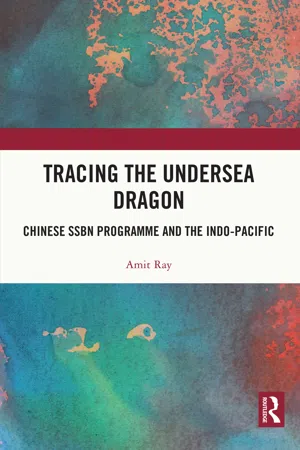
- 230 pages
- English
- ePUB (mobile friendly)
- Available on iOS & Android
About this book
This book is a comprehensive study of the development of China's nuclear-powered ballistic missile submarines (SSBNs). It offers insights into the secretive world of nuclear submarines and ballistic missiles of the Chinese (PLA) Navy and studies how these are likely to grow in the next two decades.
The volume examines the technological origins of the design and development of Chinese nuclear submarines, ballistic missiles, and their naval construction capabilities. It provides an analysis of the underlying Chinese nuclear doctrine, China's maritime geographical constraints for submarine operations, and the credibility of its sea-based deterrence. It draws upon strategy, nuclear policy, technology, geography, and operational considerations to holistically predict the likely SSBN force levels of the PLA Navy for various scenarios. The book also assesses the spectrum of threats likely from the undersea domain for India and other nations in the Indo-Pacific region.
A key text on an obscure but vital facet of Chinese defence studies, this book will be useful for scholars and researchers of strategic affairs, international relations and disarmament studies, peace and conflict studies, geopolitics, foreign policy, Indo-Pacific studies, and diplomacy.
Frequently asked questions
- Essential is ideal for learners and professionals who enjoy exploring a wide range of subjects. Access the Essential Library with 800,000+ trusted titles and best-sellers across business, personal growth, and the humanities. Includes unlimited reading time and Standard Read Aloud voice.
- Complete: Perfect for advanced learners and researchers needing full, unrestricted access. Unlock 1.4M+ books across hundreds of subjects, including academic and specialized titles. The Complete Plan also includes advanced features like Premium Read Aloud and Research Assistant.
Please note we cannot support devices running on iOS 13 and Android 7 or earlier. Learn more about using the app.
Information
Chapter 1
Introduction
The behemoth
Table of contents
- Cover
- Half Title
- Title Page
- Copyright Page
- Dedication
- Table of Contents
- List of figures
- List of tables
- Preface
- List of abbreviations
- Chapter 1: Introduction
- Chapter 2: China’s nuclear doctrine and role of SSBNs
- Chapter 3: Chinese SSBN development
- Chapter 4: SSBN readiness and deployment
- Chapter 5: Future outlook
- Chapter 6: Ramifications for the Indo-Pacific
- Chapter 7: Conclusion
- Appendices
- Index